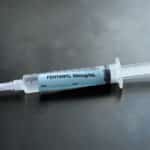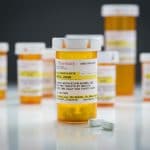- Fentanyl Origins & Medical History
- Illicit Fentanyl Production & Distribution
- The Fallout Of Illicit Fentanyl Production
- Fentanyl Overdose Signs & Symptoms
The Origin & History Of Fentanyl
According to the National Institute on Drug Abuse (NIDA), almost 92,000 individuals in the United States died from drug overdoses in 2020.
More than 68,000 of these overdose deaths involved opioids, with the powerful opioid fentanyl (and its analogues) being the deadliest.
Fentanyl Origins & Medical History
Opium has been used as a natural pain relief medicine for many thousands of years. This unique substance contains a variety of natural opiate drugs, primarily morphine, which was isolated as early as 1804.
In the decades that followed, a wide variety of opioid drugs were developed by modifying natural opiates or synthesizing new drugs with different, but related, chemical structures.
Fentanyl, a fully synthetic opioid, is one such drug. Discovered in Belgium by Paul Janssen of Janssen Pharmaceutica in 1959, it was used as a general anesthetic in 1968.
Forms Of Fentanyl Approved For Medical Use
In the 1990s and 2000s, Janssen Pharmaceutica developed several other versions of fentanyl for medical use:
- the Duragesic transdermal patch, which is a fentanyl patch worn to provide constant administration of the drug over a period of two or three days to control severe chronic pain
- Actiq, a flavored lollipop containing a special fentanyl formulation for treating breakthrough pain
- Onsolis, a fentanyl buccal soluble film that delivers a dose of the drug through the inner lining of the cheek
Other forms of fentanyl were eventually developed, including transmucosal lozenges, buccal tablets, sublingual sprays, nasal sprays, and a variety of injectable formulations.
As of 2023, fentanyl is considered a Schedule II controlled substance in the United States and is the single most widely prescribed synthetic opioid analgesic in global medicine.
Illicit Fentanyl Production & Distribution
While fentanyl is deemed an essential medicine by the World Health Organization, it is increasingly produced and sold as a dangerous recreational drug.
Its rise in the United States, accelerating since 2013, is considered to be the third and deadliest wave of the opioid crisis thus far.
In fact, fentanyl has rapidly supplanted heroin in the illicit drug trade because it offers a variety of advantages to the black market, including:
- fentanyl is 50 times stronger than heroin (smaller amounts need to be produced and transported, simplifying storage and logistics)
- fentanyl is a fully synthetic drug and does not require opium for its laboratory-based production in China, Mexico, or Southeast Asia
- a variety of fentanyl analogues exist, including sufentanil, alfentanil, and others, which have been used to confound certain aspects of international law enforcement and sidestep regulation
- fentanyl can be inserted into a variety of other counterfeited illicit or prescription drugs like oxycodone
Identifying Illicit Fentanyl
Illicit fentanyl and fentanyl analogs are produced either as a powder of varying colors, or as counterfeited tablets or pills. It may also be added into other drugs, including cocaine, heroin, amphetamine, methamphetamine, and MDMA.
The Fallout Of Illicit Fentanyl Production
As the United States has stepped up efforts to regulate and control prescription opioid misuse, illicit narcotics like fentanyl and heroin have increasingly been imported with tragic consequences:
- in 1999, at the beginning of the opioid crisis, 8,050 Americans died from opioid overdose
- by 2009, before the large-scale introduction of fentanyl, this figure had increased to 20,422
- by 2019, with heroin use spreading, these figures more than doubled again to 49,860 despite all government efforts
- in 2020, opioid deaths increased even more sharply, rising to 68,630
Fentanyl Overdose Signs & Symptoms
Any non-medical use of fentanyl or its potent analogues is dangerous. Given the drug’s strength, dosing must be performed very precisely, as any error can rapidly trigger severe opioid overdose symptoms that may include:
- sedation
- low blood pressure
- nausea/vomiting
- muscle weakness
- constricted pupils
- cold and clammy skin
- blue colored lips and fingernails
- slow heart rate
- difficulty thinking or responding to others
- coma
- breathing problems, including gasping, slow breathing, or shallow breathing
Breathing problems, known as respiratory depression, can quickly result in serious injury or death as the body loses the ability to deliver life-sustaining oxygen to the brain and vital organs.
Narcan
If you suspect a fentanyl overdose has occurred, give the victim the opioid overdose antidote naloxone (Narcan) and summon your local emergency healthcare providers.
However, note that multiple or repeated applications of naloxone may be needed to fully control fentanyl’s life-threatening effects.
If you or a loved one need support for opioid addiction, please contact us today.
Sources
- Centers for Disease Control and Prevention (CDC) — Fentanyl
- Centers for Disease Control and Prevention (CDC) — Understanding the Epidemic
- Drug Enforcement Administration (DEA) — Drug Fact Sheet: Fentanyl
- Food and Drug Administration (FDA) — Timeline of Selected FDA Activities and Significant Events Addressing Opioid Misuse and Abuse
- National Institute On Drug Abuse (NIDA) — Overdose Death Rates
Written by
Northeast Addition Editorial Team
©2024 Northeast Addition Center | All Rights Reserved
This page does not provide medical advice.





